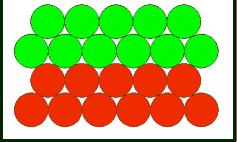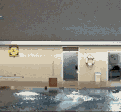Table of Contents
Law of thermodynamics
Irreversibility as an everyday experience
Every day constantly experience that many of the processes observed by us are bound to a specific chronological order. A time-reversal of such processes seems incredible.
This video is from http://www.physik.uni-mainz.de/Lehramt/ViMPS/Videos/Wasserspringen.html from the database ViMPS of Mainz University. Processed and “reversed” by W. Feist (source: Dr. Friedrich Kayser StR Lars-Patrick May)
Example: a roof tile that falls from the roof onto the road and breaks into pieces. No-one would seriously claim that a time-reversal of this process would be possible. A witness claiming such a process would have no credibility in a court. The reversal process would follow the laws of microscopic mechanics at all times. For the reversal process, the law of energy conservation or the “first law of thermodynamics” must also be fulfilled at all times. This process is not impossible – it is only so extremely unlikely that it does not happen in practice.
The experience of non-reversibility (the expert term is “irreversibility”) of certain processes is so evident that it is included as a basic statement (axiom) in the theoretical building of thermodynamics: this basic statement forms the second law of thermodynamics. It actually involves nothing other than that it excludes processes like the one shown in the “false” video on the top right.
The second law of thermodynamics is one of the foundations of thermodynamics; it is not proved in the context of this theory, but rather its evidence derives from the everyday experiences mentioned above and from a multitude of experimental observations. Despite many efforts, to date no-one has managed to observe in a reproducible way macroscopic processes which contradict the second law of thermodynamics. Instead, all experiences support the second law of thermodynamics – that is the reason why it was formulated at all in the first place. A long discussion about its truth, evidence and provability could ensue here as well - see earlier comment on the nature of scientific knowledge.
 There are 22 marbles in this glass, which are all identically manufactured, only their colour is different. You now shake the glass hard, what does the result look like? |
|
| Like this? | Or more like this? |
 |  |
However, a more in-depth understanding is possible in the context of statistical mechanics. There it can be seen that the second law of thermodynamics corresponds to the striving of a system consisting of many small mixed individual parts towards “equal distribution” – the natural distribution is thus maximum “chaos” so to speak, as long as there are no serious reasons specifically counteracting this. This can be regarded as the probabilistic reasoning behind the second law of thermodynamics – the axiomatics then shift to the even more elementary axioms of the probabilistic theory.
Formulation of the second law of thermodynamics
The following formulations of the second law of thermodynamics are equivalent to one another. A tip for all those who are less familiar with physical parameters and equations: the basic principles of the second law of thermodynamics are included in each of the formulations below, so the time being you won't have to struggle with trying to understanding the other formulations which do not mean much to you. The diversity of the at first glance very different formulations is an indication of the fundamental significance of this sentence 1)
| (A) In the overall balance, heat never flows from the colder to the warmer medium by itself. | Got it … ? |
| (B) There is no such thing as a “perpetuum mobile” of the second kind. | That's a machine which does nothing other than constantly take heat from a single thermal reservoir and convert it entirely into work. |
| (C) A “power plant” can only obtain useful work from the heat $Q$, which is taken from a reservoir with a high temperature $T_h$, if it can also simultaneously give off part of this heat to a second reservoir with a lower (“cool”) temperature $T_c$ (often the “environment”). The maximum work $W$ that can be gained from the heat taken from the above(first??) reservoir amounts to $\eta_{Carnot}\cdot Q$ where $ηCarnot$ is the so-called Carnot efficiency: ${\displaystyle \eta_{Carnot}=1-\frac{T_c}{T_h}}$ | * a power plant is a machine the purpose of which is to convert heat into work and which makes use of a heat source for this purpose. * A reservoir is a thermodynamic equilibrium system which maintains its state of constant temperature even with withdrawal and supply of heat.2) |
| (D) Exergy $\mathbb{E}$ in a closed system cannot increase over the course of time. | Exergy $\mathbb{E}$ is the maximum amount of work that can be gained from a system through an ideal change of state if a reservoir with a temperature $T_c$ is available as a second system. |
| (E) Entropy $S$ cannot decrease in a closed system over the course of time. | Entropy $S$ is a measure of the energy contained in a system which is transferable only as heat. It can only be seen as a measure of the extent of information which is not available through the system. |
Note: Relationship to the Passive House concept
The Passive House concept does not work against the laws of physics - that also wouldn't make sense, how could it function reliably otherwise? Instead, the Passive House concept is based on physics and applies this knowledge intelligently. Making practical use of physics in an innovative way does not always require high-energy accelerators in the GeV range. Classic thermodynamics also holds many innovative and beneficial applications.
The Passive House concept does not contradict the second law of thermodynamics - but it does use all the tricks known today in order to come as close to reversibility as possible. These are more or less the same tricks as those which a good experimental physicist must use if he wants to perform classical mechanics experiments or demonstrations relating to classical energy conservation without any “unwanted side effects/aberrations”.
And these are almost exactly the same methods used by a physics lab when one wants to run a thermodynamic machine with an acceptable efficiency: for this purpose the experimenter must seek to keep all kinds of energy losses low: friction losses, flow losses and heat losses. Of course, this never succeeds 100% - but over time the technology will become better and better and there will be success in bringing the efficiencies increasingly closer to the physical optimum. Now, where this optimum lies exactly is one of the statements that are equivalent in the second law of thermodynamics. What this is all about is explained on the following pages.
To prove the equivalence of the formulations
The objective of the explanations relating to the second law of thermodynamics is to provide evidence (German only) of the equivalence of the statements given above. This is actually easier than many think possible at first. That the statements initially appear 'strange' is mainly due to the fact that the associated terms are not familiar in the first place. We will therefore introduce, explain and illustrate these step by step using examples.
Apart from this, the basic concept for a reversibly functioning thermal machine is required for proving this - a machine which moves heat between two systems with a constant temperature level, in a way that permits all individual steps to be gone through also in the opposite direction - thus ALSO for these thermal processes. “Normally” it's not like this here (see our example with the tile jumping back to the roof). Normally heat transport from one system with a high temperature $T_h$ into one with a lower temperature $T_c$ is an especially excellent example of a non-reversible process - this exactly is the3) statement in the first formulation of the second law of thermodynamics: heat from the system with the lower temperature4) simply doesn't flow back towards the hotter system. However, with the trick described in the section on the Stirling engine (German only), it is actually possible to move heat from the cold system back to the hot system - but work must be applied for this5). Of course, the associated work must be available first - the brilliance of this engine exactly is that this work can be extracted during the transportation of heat from the hot to the cold system (and then e.g. stored in a flywheel). Amazingly, the same machine can do both, what matters is whether it is operated clockwise or counter-clockwise. Irreversibility in thermodynamics can thus be tricked with machines of this kind. The best thing about this concept is that this machine can even be built in practice in excellent approximation - it is even possible to actually order a simple demonstration model.


